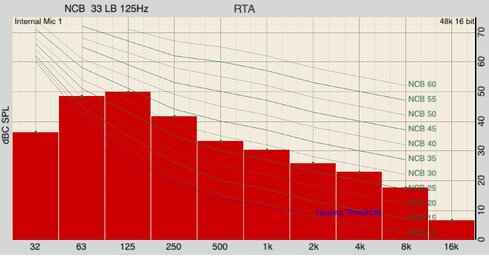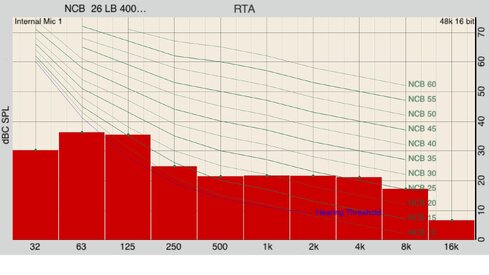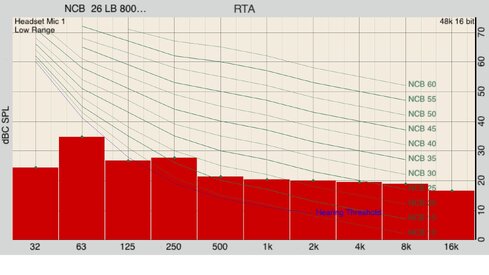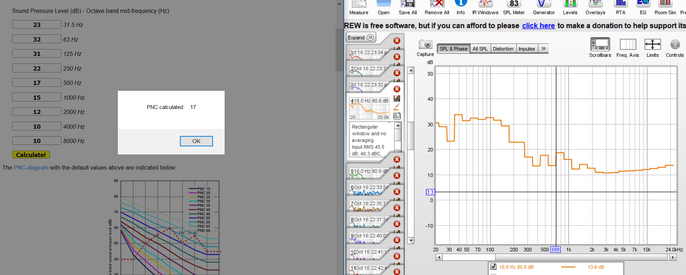Matthew J Poes
AV Addict
Thread Starter
- Joined
- Oct 18, 2017
- Posts
- 1,905
I finally decided to download AudioTools onto my phone and calibrate my iMM-6 mic to measure transmission loss and noise criteria. It will be a while before I can do transmission loss, but I did a quick NC study using the NCB standard. NCB stands for Balanced Noise Criteria.
As a quick background, an anechoic chamber would measure below 0. Paul Barton recently told me that NRC measures 20dbs below human hearing perception, as a point of comparison. A really quiet studio would have an NCB level of around 10-15dbs. A really quiet theater would typically fall between 15db and 25db (depending on the heroic levels one went to in order to achieve this level).
A normal room is going to be around 30-35db when it’s quiet. With background tv, people talking, etc. this level would quickly jump to between 55 and 65 dbs.
Now the iMM-6 still is not a lab grade microphone and it has clear noise issues. This is causing a raised high frequency noise floor suggesting that my room is noisier than it really is. My guess is that above about 2000hz the noise measurement is mostly mic capsule noise.
First the room immediately adjacent to my theater. A good reference since this is the noise level I was keeping out of the theater. My basement is noisier than other rooms in my house. NCB 33, meaning it matched the 33db curve based on the 125hz band.

Now for the theater. This shows that I exceed the NCB 25 curve at 4khz and get a score of NCB 26. I happen to believe this is mic noise.

More interesting may be the reduction in the Lf noise floor. This is largely HVAC noise and it’s clearly much lower in the theater. In fact the ambient noise is below the threshold of hearing by about 100hz.
For anyone with an iPhone and $10, you can try this for yourself. The HF response of the iPhone is rolled off so you will get false results at 16khz. For this test it doesn’t matter. This is an RTA test set to one octave (that’s the standard) and using a noise curve overlay. I used NCB. I also shared pics from my room using the internal mic because I wanted others to be able to share. The iMM-6 looks basically the same but with the 16khz bar raised to be flat with the other bars.
Ok I’m editing to add the iMM6. Silly to mention it and not share the measurement.
As a quick background, an anechoic chamber would measure below 0. Paul Barton recently told me that NRC measures 20dbs below human hearing perception, as a point of comparison. A really quiet studio would have an NCB level of around 10-15dbs. A really quiet theater would typically fall between 15db and 25db (depending on the heroic levels one went to in order to achieve this level).
A normal room is going to be around 30-35db when it’s quiet. With background tv, people talking, etc. this level would quickly jump to between 55 and 65 dbs.
Now the iMM-6 still is not a lab grade microphone and it has clear noise issues. This is causing a raised high frequency noise floor suggesting that my room is noisier than it really is. My guess is that above about 2000hz the noise measurement is mostly mic capsule noise.
First the room immediately adjacent to my theater. A good reference since this is the noise level I was keeping out of the theater. My basement is noisier than other rooms in my house. NCB 33, meaning it matched the 33db curve based on the 125hz band.

Now for the theater. This shows that I exceed the NCB 25 curve at 4khz and get a score of NCB 26. I happen to believe this is mic noise.

More interesting may be the reduction in the Lf noise floor. This is largely HVAC noise and it’s clearly much lower in the theater. In fact the ambient noise is below the threshold of hearing by about 100hz.
For anyone with an iPhone and $10, you can try this for yourself. The HF response of the iPhone is rolled off so you will get false results at 16khz. For this test it doesn’t matter. This is an RTA test set to one octave (that’s the standard) and using a noise curve overlay. I used NCB. I also shared pics from my room using the internal mic because I wanted others to be able to share. The iMM-6 looks basically the same but with the 16khz bar raised to be flat with the other bars.
Ok I’m editing to add the iMM6. Silly to mention it and not share the measurement.












